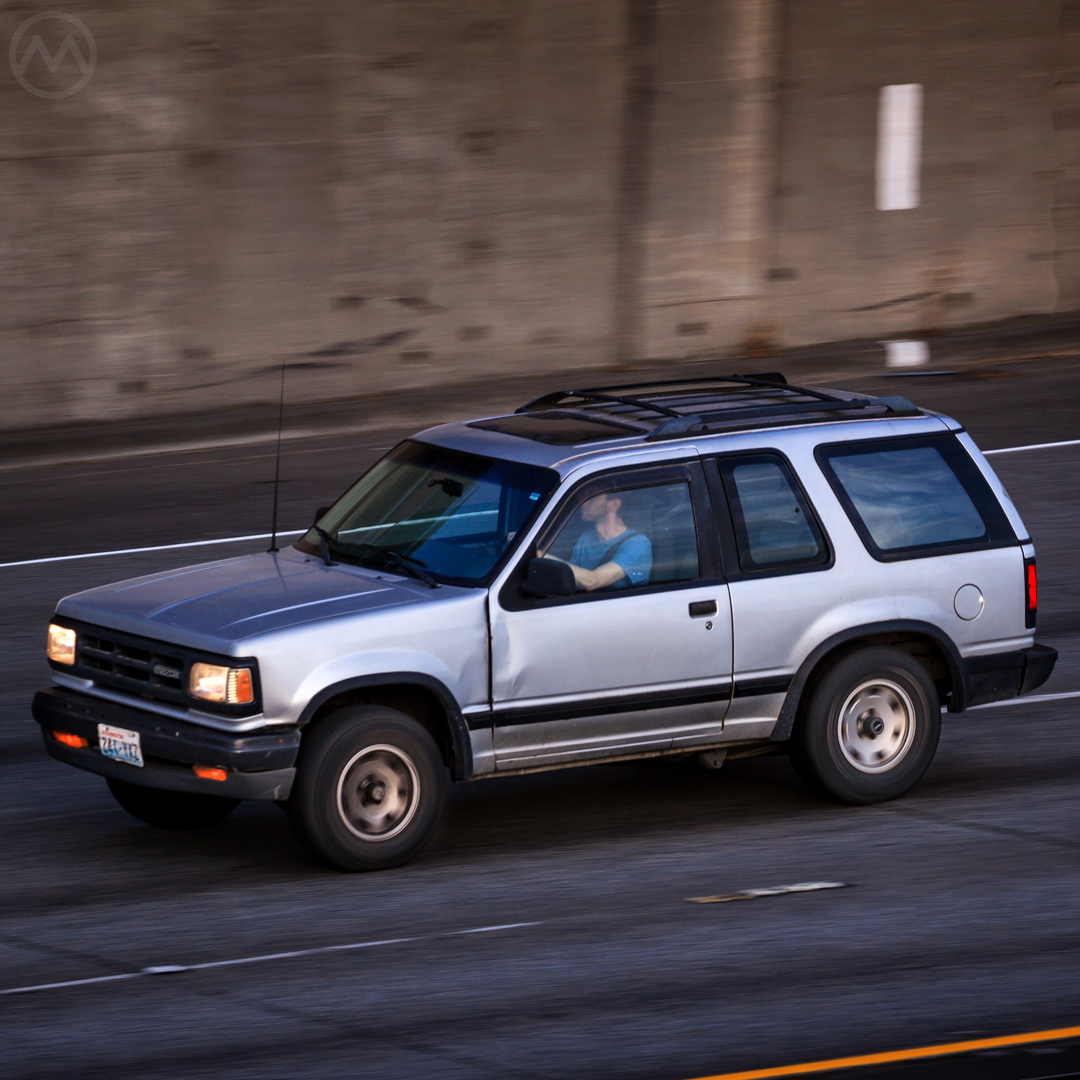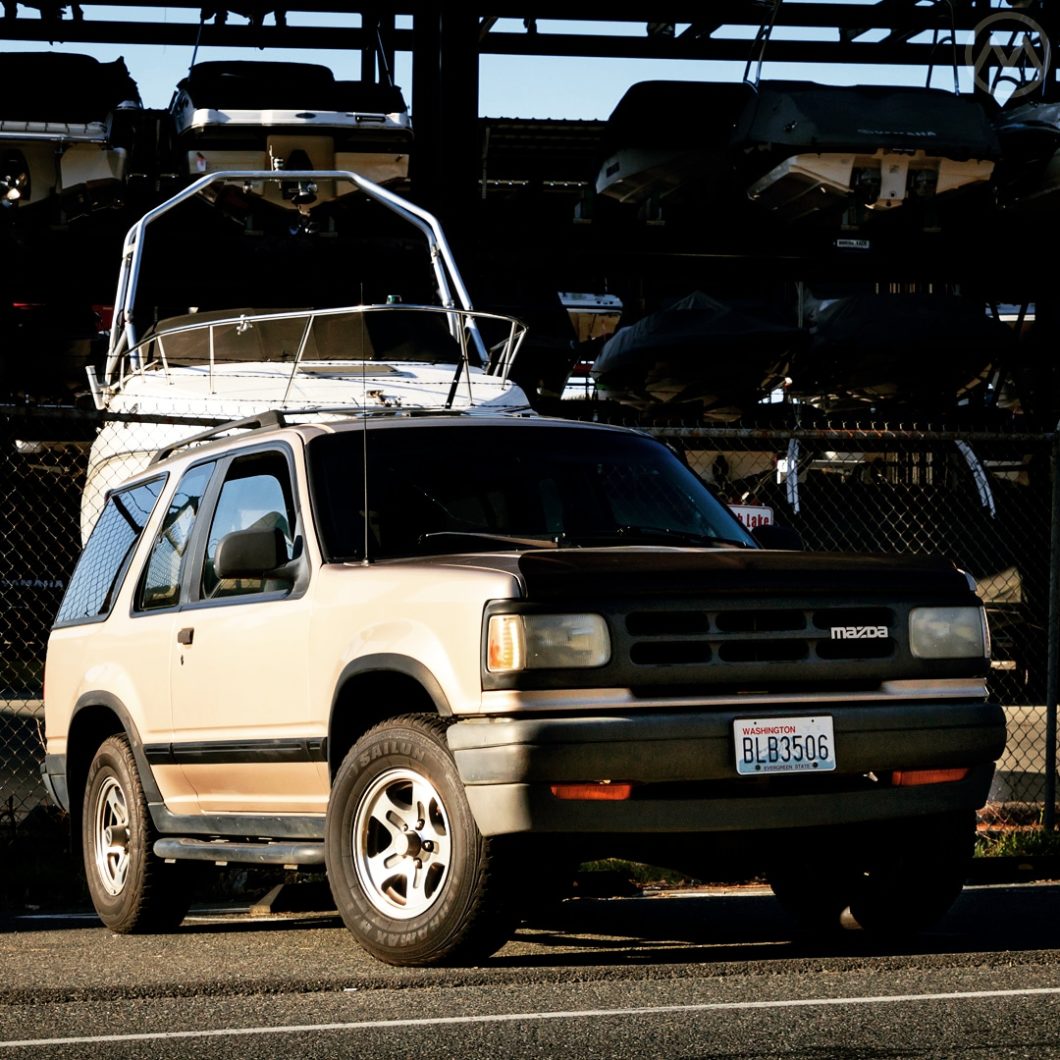“America builds one for the Japanese!” read the headline introducing the Mazda Navajo. It came after almost two decades of American brands offering “captive import” Japanese vehicles (starting in the early 1970s with the Dodge Colt, Chevy LUV, and Ford Courier). The huge global rise of Japanese cars in that time frame also meant that a U.S. domestic manufacturer building a vehicle for a Japanese one really was a newsworthy headline.
The Navajo wasn’t the first Mazda to be built in North America, but it was a horse of a very different color than the other Mazdas. It also wasn’t the first foreign design to be rebadged into a Mazda – the Australian-sourced Roadpacer had that honor 15 years prior. But it was the first time a U.S. Domestic car was rebadged into a Japanese one for U.S. consumption.
Even a casual glance reveals that the Navajo is a Ford Explorer fancier Mazda threads. Still, Mazda had good reasons for offering the Navajo and high hopes for it when it was new. What held it back, ultimately, was not that it was a badge job, but that two-door SUVs were fading away by the time it arrived.
It came only as a two-door in part because of objections from Ford’s U.S. dealers, who wanted the Explorer for themselves. The story begins with the rise of family-oriented SUVs in the early 1980s.
SUVs Go Mainstream
Ford was actually behind the curve in coming to market with the Explorer – a story we’ve told previously, but in the early 1980s a flurry of newer, lighter, more car-like SUVs began displacing the old full-size Blazers, Ramchargers, and Scouts. This phenomenon took place on both sides of the Pacific Ocean. In Japan, Mitsubishi and Isuzu were on the vanguard. In America Ford and GM launched the 2-door S-10 Blazer/Jimmy in 1982 and Jeep the landmark XJ Cherokee in 1983.
In the wake of the Cherokee, Montero, and Trooper, Nissan and Toyota also launched casual SUVs that they federalized to huge sales success in the late 1980s. At first, many were offered only as two-door vehicles, but the Cherokee pointed the way to the four-door mainstream.
The Japanese entries enjoyed huge success despite voluntary import quotas (enacted under the Reagan administration). The quotas didn’t diminish demand for what customers correctly saw as well-made, reliable, modern cars from Japan; instead having the effect of driving prices (and profits) up and giving birth to the Japanese premium brands.
Another factor came along in 1989 to change the dynamics of this market – an alteration to the “Chicken Tax.”
The infamous “Chicken Tax,” a tariff of 25% on light trucks, is still today a seemingly permanent remnant of an early 1960s trade dispute between the U.S. and Western European Farmers. Initially targeted the Volkswagen Type 2 pickup, but long after the trade dispute was over, it remained a barrier to all foreign light trucks, including many produced by the Big 3 themselves.
The “Chicken Tax” did not apply to SUVs until 1989 – because they had finished interiors and were passenger vehicles. That year U.S. Customs reclassified two-door SUVs as trucks, which had the effect of inflating their prices exactly at a time when four-door SUVs were surging. Toyota and Nissan appealed this decision but it wasn’t resolved until 1994.
Mazda had no U.S. SUVs but correctly saw how much money its Japanese competitors were making off of the new breed of family-friendly trucks. So in 1988-89, Mazda North America was trying to figure out a relatively easy way of getting in on the action.
Mazda Proceed
Mazda actually had a kind of SUV in its JDM lineup – the B-series wagon/Proceed Marvie, essentially a big wagon based on the B-series pickup. Just as Toyota’s 4Runner was a direct relative of the HiLux pickup, so too the Proceed/Marvie was a full-bodied wagon on the Mazda pickup chassis.
This relatively low-slung truck was offered in many markets in Asia and sold in Australia (as many Mazdas were) under Ford’s label – under the name Ford Raider. Coincidentally, Dodge’s U.S. captive version of Mitsubishi’s Montero was also called “Raider.” The Proceed/Marvie came only with the four-cylinder engines of the B-series, which were unlikely to be competitive against six-cylinder competitors.
The company had also made a huge investment in a brand new Minivan, the MPV, for that other market of family machines that was exploding in the late 1980s. The MPV was a taller and more truck-like Minivan than many of its competitors, and designed with 4WD capability baked in. Mazda had essentially hoped to rope in some SUV customers who wanted to split the difference between a Minivan and a truck.
The MPV would arrive as a 1989 model, and Mazda North America spent big on a PR blitz for it.
Creating the Navajo
Those factors in mind, Mazda chose not to adapt the Proceed/Marvie for the USA and turned to its partner Ford, for an U.S. SUV that would circumvent any quotas or tariffs and cost less to develop.
Ford had owned nearly a quarter of Mazda since 1979 and the two companies were closely tied up in many projects across the globe. These included everything from the Korean-built Festiva to the Ford Probe and Mazda MX-6, built at Mazda’s JV facility in Flat Rock, Michigan, and many more.
In 1989, Mazda was knee-deep in helping Ford re-engineer it’s best-selling U.S. Escort onto a Mazda-based platform. With Ford almost ready to launch the Jeep Cherokee-influenced Explorer, which promised to be a big hit in early marketing clinics, there was a ready-made solution for Mazda USA.

A little bit of restyling both inside and out, and the Explorer could become Mazda’s new SUV. The name would be “Navajo,” a twice-over bit of appropriation in grabbing an evocative name belonging to real people, but also in that it was clearly a reference to the Cherokee.
But in the development process of this badge-engineered twin, Ford dealers protested that the Explorer four-door should be theirs alone – and they got their way, according to Mazda North America product planner Bob Hammond. The Navajo would have to be a 2-door only product for Mazda. Ford also offered a 2-door Explorer, the Explorer Sport – which was much the same in many ways.
The Navajo would be offered only in North America, and built on the same line as the Explorer in Louisville, KY.
To differentiate it, the Navajo would be billed as a more rugged version of the truck, with blackout trim and different fabrics, wheels, and different packages of features. There would be an extensive option list to turn it from a relatively basic truck into a leather-lined luxury machine – the full leather option was a $3,100 addition. The overall look was more restrained than the Explorer and vaguely more like an Audi product in style – sober and functional.
Like all first-gen Explorers, all Navajos used Ford’s 4.0L V6, either with a manual or an automatic. Not a terrible setup and Explorer customers didn’t seem to mind, but both vehicles were slow compared to a Cherokee and certain other trucks of the time.
The Explorer’s basic suspension, derived from the Ranger, didn’t make the Navajo the best offroader. Neither it nor the Explorer were on par with the Cherokee off road, but in 2-door form the shorter truck was more capable in the mud than the typical 4-door Explorer.
The Navajo appeared in the summer of 1991, but by then the market for 2-door SUVs was already cooling.
A small and dedicated base of customers, mostly buyers under 30, still wanted 2-door “active lifestyle” vehicles, but the big audience was families trading in sedans, station wagons, and minivans for something that had the room of a wagon but the image of an off-road bruiser. They wanted four doors, and the Explore was pitch-perfect for this mission.
The younger buyers were increasingly turning to Jeep, Nissan, or Isuzu, with the Navajo and Explorer Sport seen as also-rans. Being only a two-door, the Mazda was all but invisible to family buyers, who were usually shepherded to an MPV if they showed up at the Mazda store.
Fade to Black
The Navajo’s high-profile launch and eye-catching headlines were followed by four years of slow sales as 2-door SUVs continued to decline. As an Explorer redesign began to take shape, Mazda again lobbied for a four-door version of the Navajo in 1993-94, but no version was forthcoming.
Mazda eventually made it clear – if there wasn’t going to be a four-door Navajo, there wouldn’t be one at all. Ford still balked. After about 40,000 sales in four years, Mazda quietly pulled the plug on the Navajo in 1994.
A major factor was the supply of Explorers – Ford simply couldn’t build enough of them. Contrast the Navajo’s tiny numbers to Ford selling 300,000+ explorers a year. Eventually a second plant was added and provisioning factory capacity for Mazda’s slow seller was abandoned. Notably too, only 12-15% of Explorers were 2-doors.
Mazda’s fortunes had also changed dramatically. Hit hard by the long Japanese economic stagnation of the 1990s, Hiroshima was increasingly dependent on Ford and had less leverage to bargain with. In 1996, Ford upped its stake to 33% and put many more Ford execs in positions of power there.

Mazda also eventually killed off the Japan-sourced B-series pickup because the “Chicken Tax,” kept pushing up its price despite the very capable truck having a loyal audience. About a year before the Navajo was shuffled off to the glue factory, it was joined in Kentucky by the next B-series, a Mazda-ized version of Ford’s own Ranger, itself the basis for both the Explorer and the Navajo.
Unlike the Navajo, Ford dealers had little objection to the Ranger-based B-series, and it continued on sale for a long time – into 2009. Mazda also eventually got a version of the Ford Escape SUV, the Mazda Tribute, but this was after Ford and Mazda were tied more closely together.

